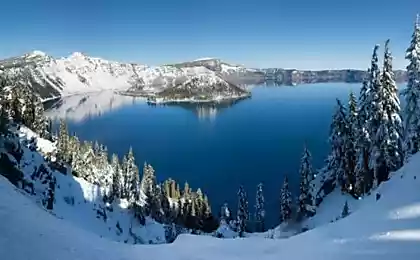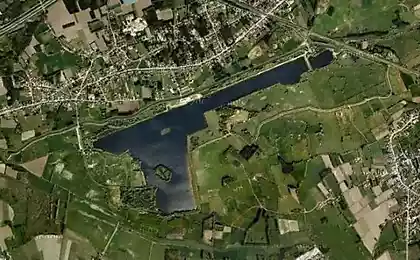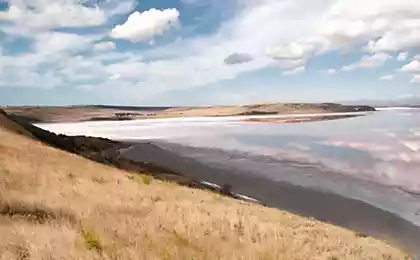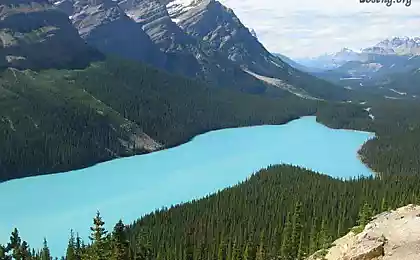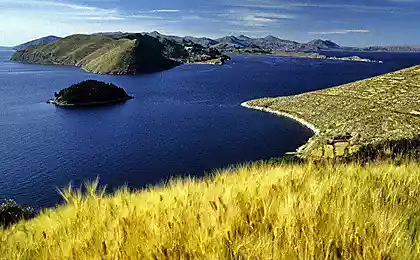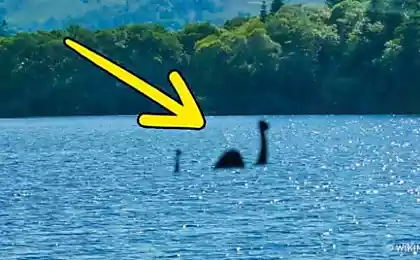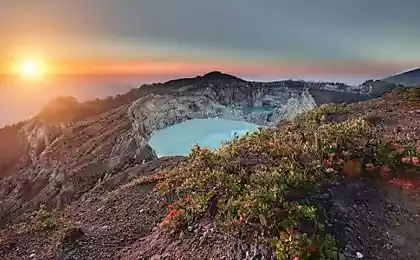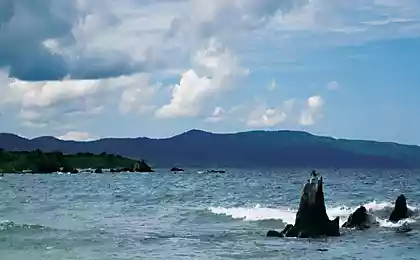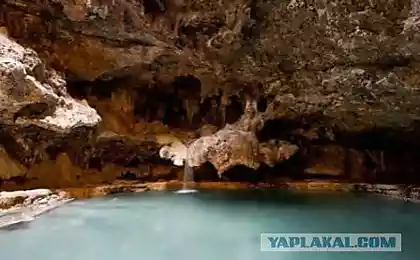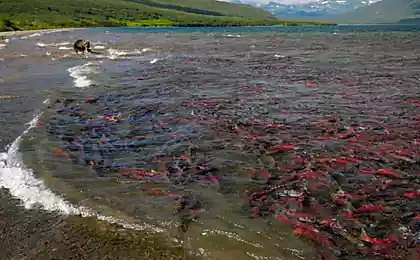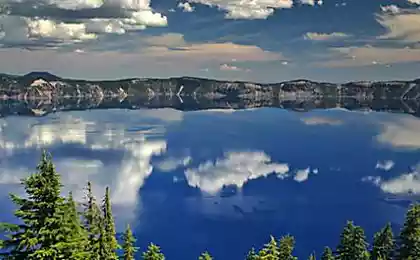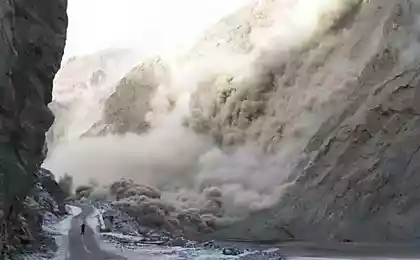1094
Kuril Lake in Kamchatka
42 photos, please be patient.
Photographer Igor Shpilenok
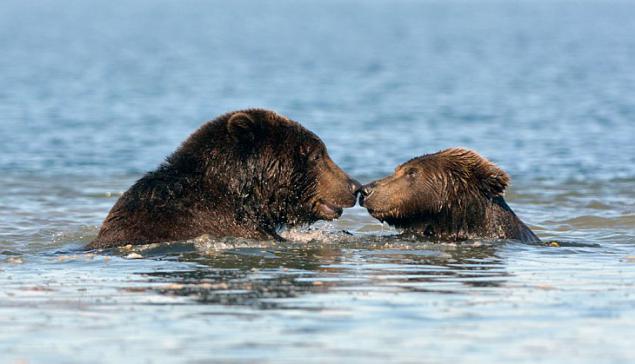
Kuril Lake in Kamchatka - the most bearish in Russia. Apparently, also in the world. Aerial surveys of this year have shown that in the vicinity of the lake inhabited by more than a thousand bears! Yes, that aerial surveys, I myself have repeatedly been able to see here bears to one hundred per day!
Cordon at Cape Grassy - and my favorite place in the Kuril Lake. Tourist season on the lake is nearing completion. Soon the bad weather season. At the inspectors working here comes the holiday season. And for me the off-season - favorite time. So I'll be here for a replacement before winter.
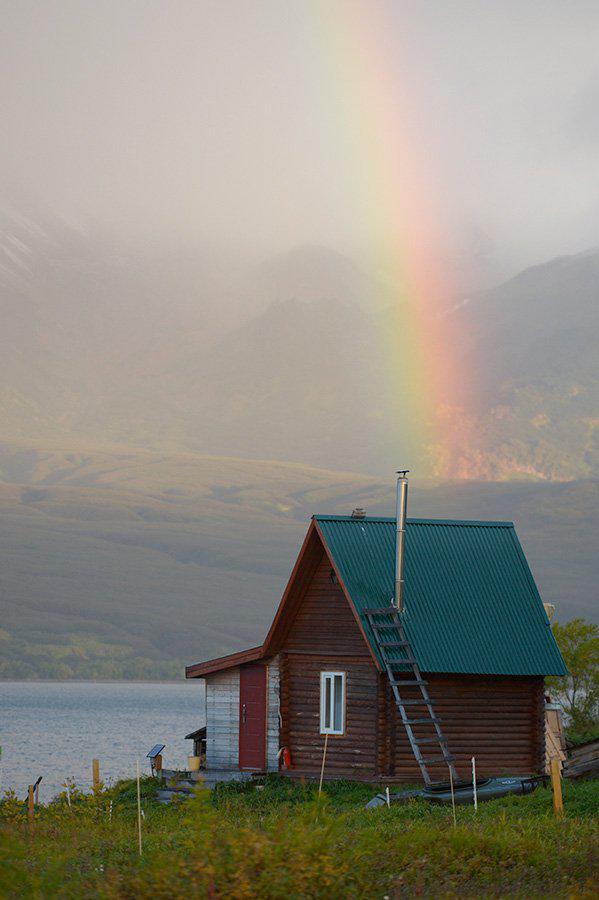
In this picture you can see the entire economy: the left two house inspector. A large building on the right - a hotel for visitors. Buildings are connected by flat wooden pathways. Green Square - helipad:

At the center of the frame - Cape Herb and Kuril Lake. Aerial view:
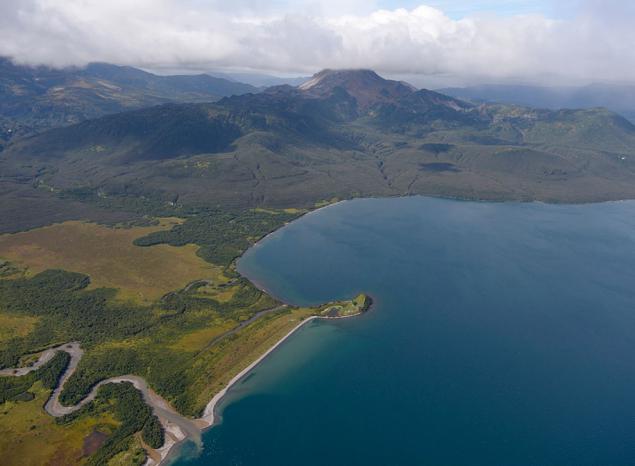
This picture I made on the first day before sunrise: decided to see how the newly purchased Nikon D4 at dusk. Fortunately I did not have to go far: the closest bear wandered along the beach just a few hundred meters from the cordon:
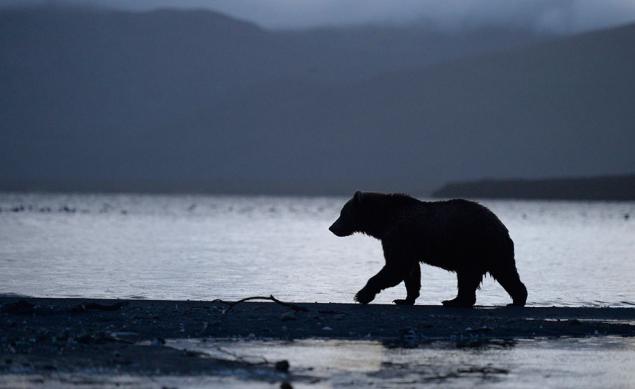
Uzon Caldera, located on the territory of the Kronotsky Nature Reserve south of the Kronotsky lake on the Kamchatka Peninsula:
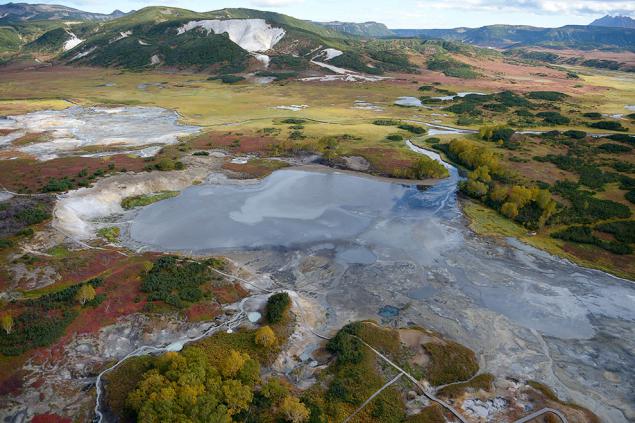
Astute readers will have noticed the gray stripes on the previous helicopter shot caldera Uzon. Fortunately, this is not the roads, grazing and wood trails. Wrong those who thought it was a concern for the purity of shoes tourists. These trails are paving where tundra and bog soils are particularly vulnerable. This is especially true for the Valley of the Geysers and the caldera Uzon - a world famous tourist destination. Visitors arriving by helicopter must not leave the wooden decks and paths.
Construction and maintenance of trails in the order - a troublesome and expensive activity, because each board has to take the place of helicopter:
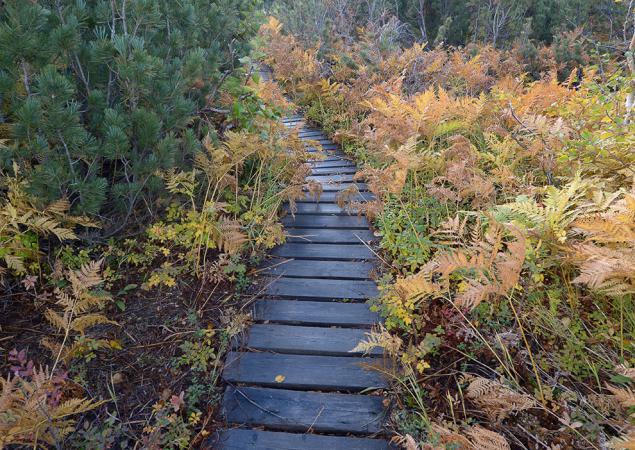
There on unknown paths traces of unseen beasts ...

09

10

Animals on the far cordon:
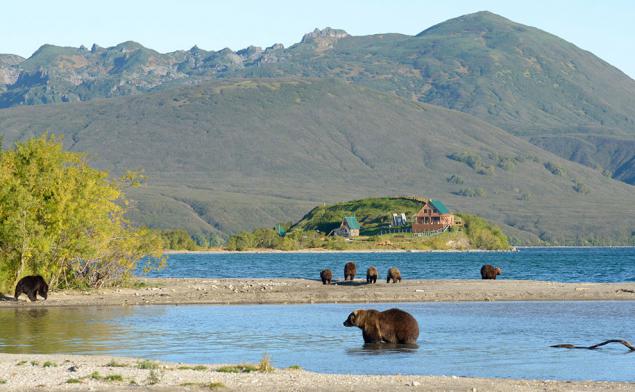
End of September. It is already the third day of Indian summer. Happy bright, very nekamchatskoe sun, blue sky and blue water, and in the morning to ten o'clock, a thick fog. We wander in a daze, constantly bumping into bears:
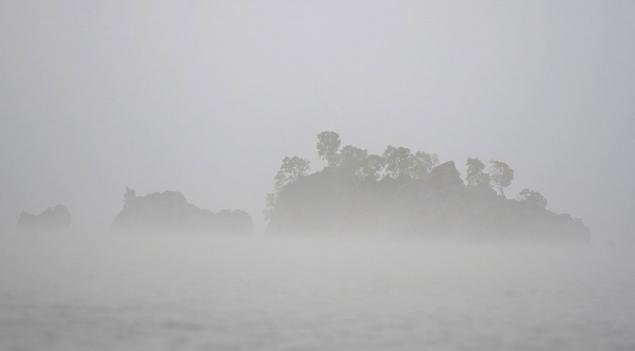
13
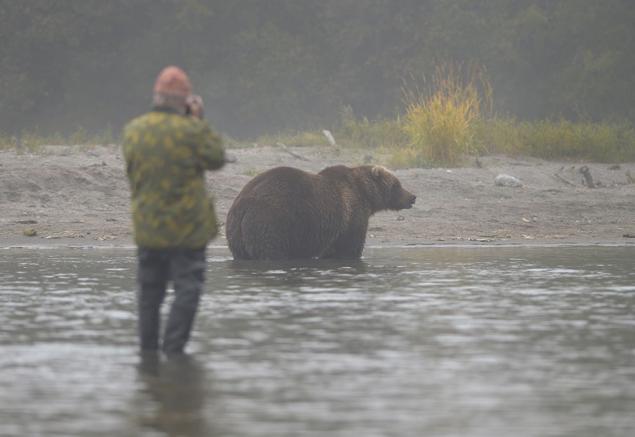
14

15
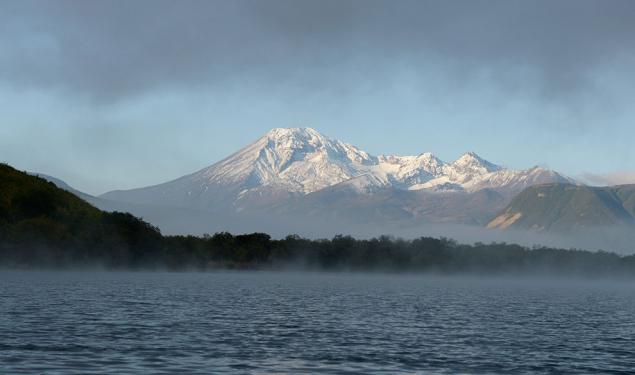
16
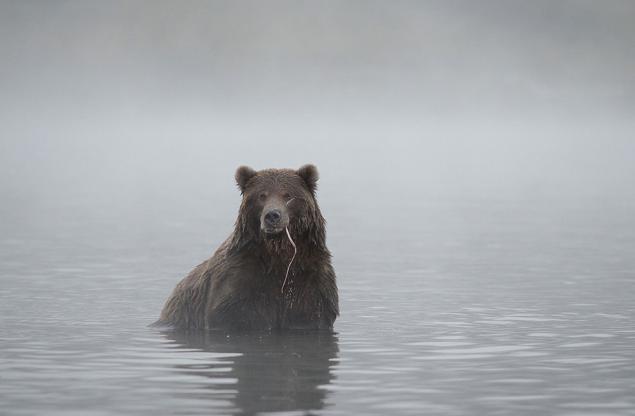
Nose to nose:
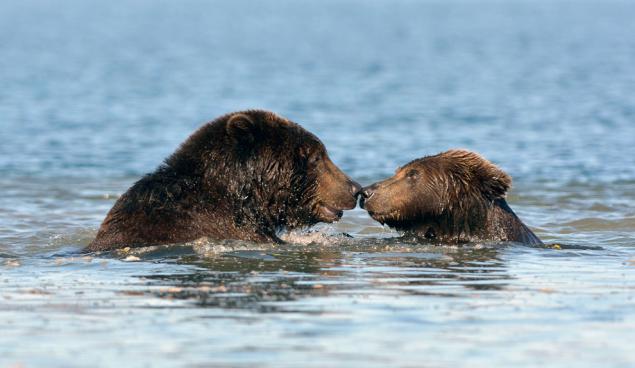
Few talk about the place where I work right now ...
State natural reserve "South Kamchatka" in its present borders was organized in 1983 and is located in the south of the Kamchatka Peninsula. Its area is 322 thousand hectares, including a three-mile surrounding marine area. In addition to the Kurile Lake, under the protection of the reserve there are unique objects such as the active volcanoes Ilyinsky, wild comb Kambalny, Koshelevo, Cape Lopatka, Lake Kambalny Island Utashud.
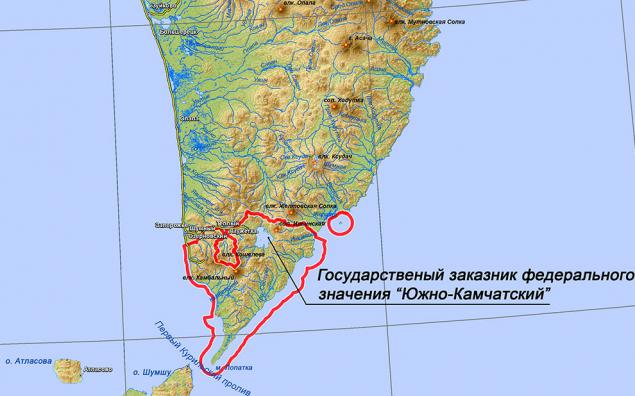
The reserve protected animals such as sea otters, sea lions, bighorn sheep, white-tailed eagles and Steller's sea eagle, golden eagle, bear, salmon, and many others. This is the only reserve at the federal level in the Kamchatka region. Mode territory close to the reserved, is prohibited in almost all kinds of wildlife, including hunting, commercial fishing, logging, land reclamation, exploration and production of minerals. In 1996, the territory of the reserve was included in the List of World Cultural and Natural Heritage Site by UNESCO as part of the category "Volcanoes of Kamchatka". The reserve is not settlements.
Now more detail about the Kuril Lake. Approximately 8000 ago in the south of Kamchatka, a series of grandiose volcanic disasters. In terms of red-hot debris ejected mass eruption is at least seven to eight times higher than the eruption of Krakatoa in 1883. Melt flow reached both coasts of Kamchatka - Okhotsk and the Pacific.
There is no doubt that in the south of Kamchatka after this eruption some time there was a volcanic desert. All living things, which was not able to move to a safe distance, was destroyed. At the site of a giant failure formed volcanic bowl - a caldera, which gradually began to fill with water. Thus was born the Kuril Lake:
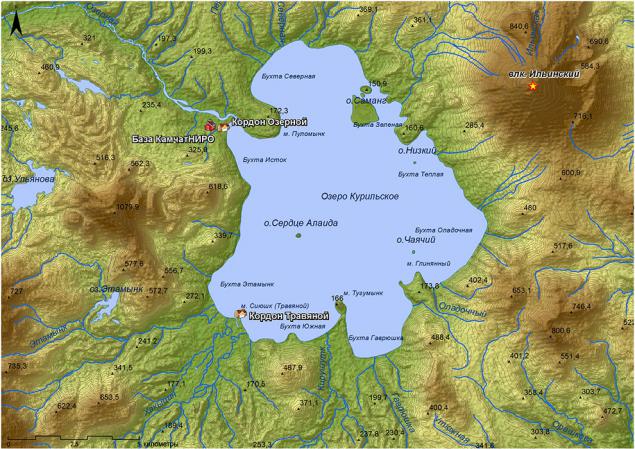
Volcano Elias hill rises above the water table area of 77 square kilometers. The volume of water in the lake of 15 cubic kilometers, the average depth of 195 meters, a complete change of water during 18 years, the average transparency of water in summer - 10 meters. The maximum depth of the lake - 316 meters.
Ilyinsky volcano - one of the most beautiful with the correct conical shape. The height of 1578 meters, the diameter of the base - 8 km. This volcano - the most noticeable decoration in the panorama of the lake. Where the slope of the volcano is in contact with the waters of the Kurile Lake, in the bay of warm, is a hot beach with access to the thermal waters. I made a couple of attempts to relax on this beach, but each time was expelled bears: directly on the narrow strip of sand is the vibrant animal tracks between spawning grounds:
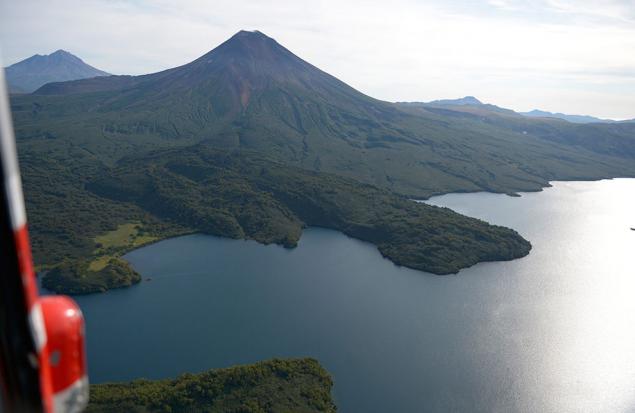
Rock Island Samang:
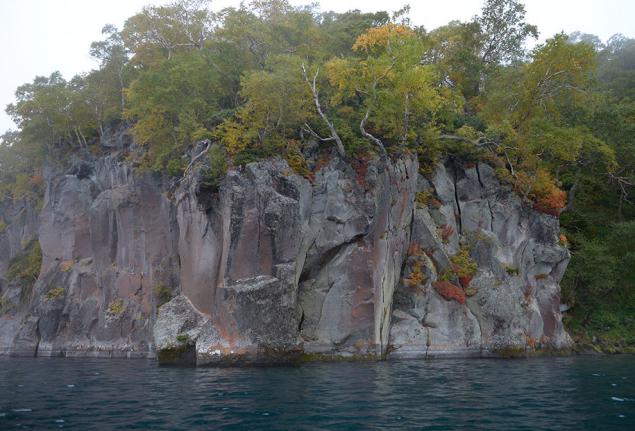
Lava islands near the volcano Elias hill:
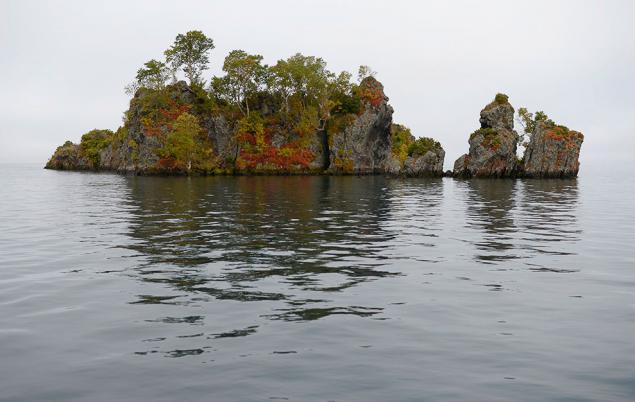
Surrounding neighborhood lake. Hakytsin River, which flows into the lake near the cordon Herbal. The mouth of this river can be clearly seen through the window of my house. Right now there are running the fish heels clumsy ...
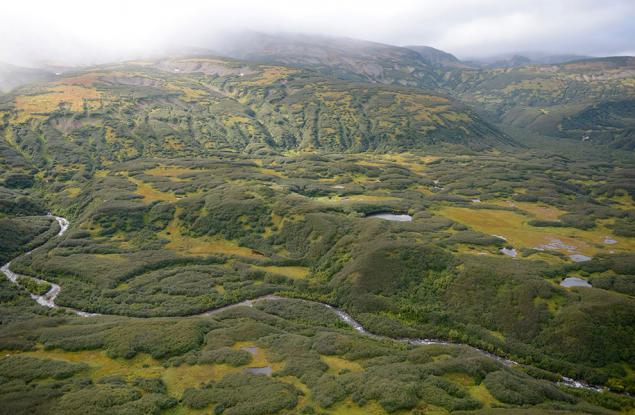
Author photo:
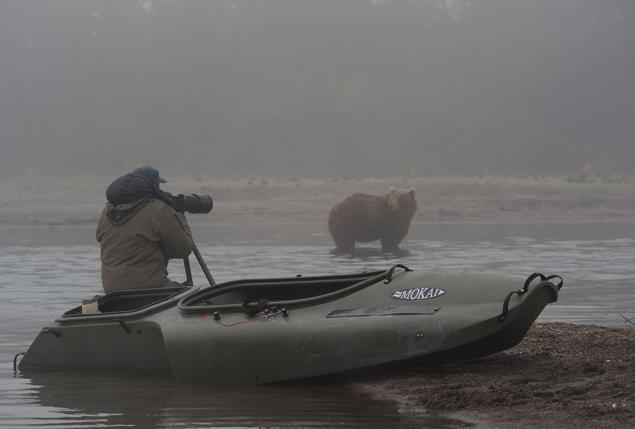
Near Cordon at Cape Grassy ... well, there was a bear of very large forms. I nicknamed her Eve:

We continue to get acquainted with bears on Kamchatka. Quarrel:
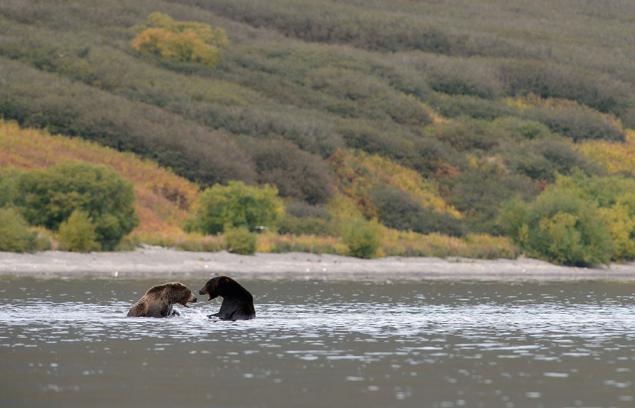
Evening at the Kuril Lake:
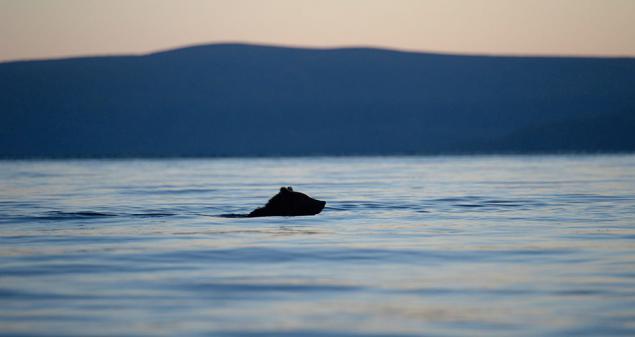
Season fish gluttony. On the cubs are now a sorry sight. Sit, hiccuping and panting heavily, at times falling into a food coma. They look like bloated ticks. Play can no longer. Soon the den ...

Suddenly - a fox. Yet this is not the place of Kamchatka fox:

Early October. Postcard golden autumn in Kamchatka:
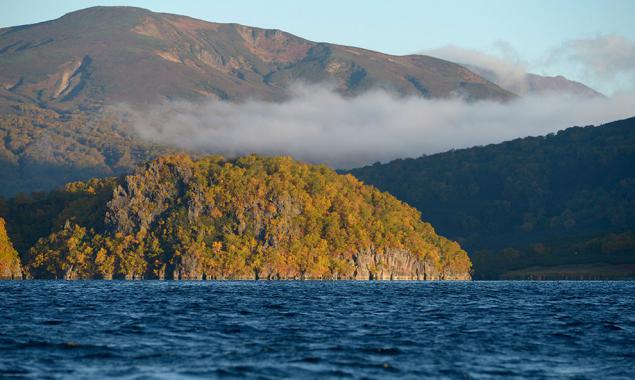
Beauty
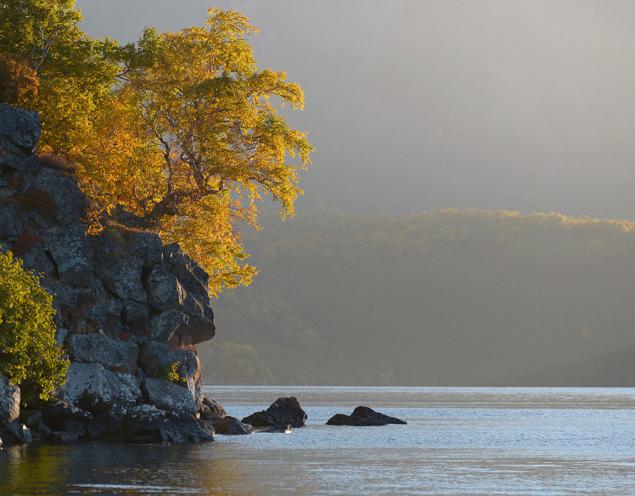
Volcano
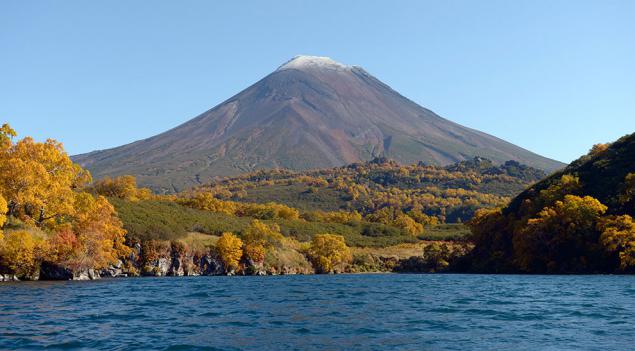
October 7, 2012. The last hours of autumn colors. East wind had pulled from the ocean mane approaching cyclone that sderet leaves of willows and birches, whitewashed mountain peaks and volcanoes with fresh snow. There comes another stage fall ...

Frost
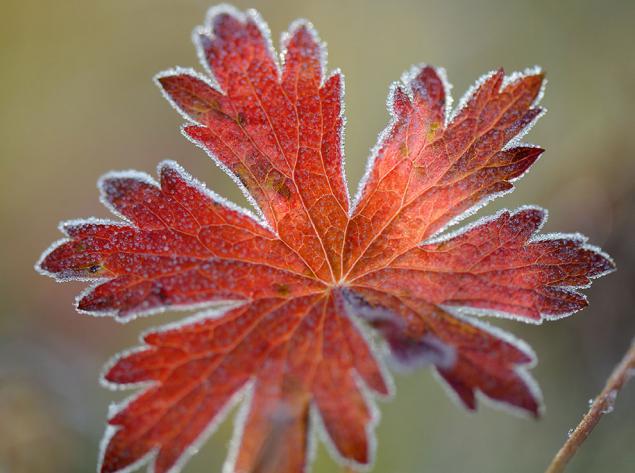
Early in the morning:
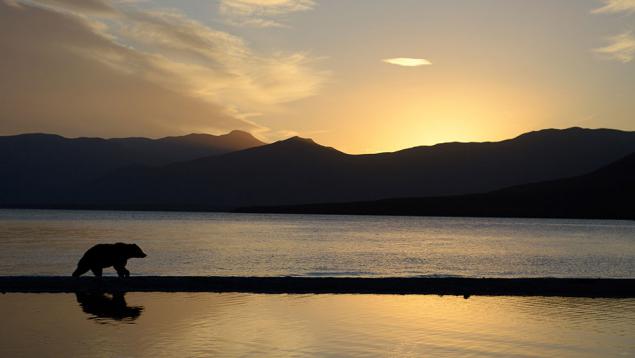
Helipad at dawn. Night cordon Grass is always filled with the sounds. The lapping of waves, the sound of a distant waterfall, bear sighs from the bushes. But traces of nightlife Frozen helipad. What they had a disco here?
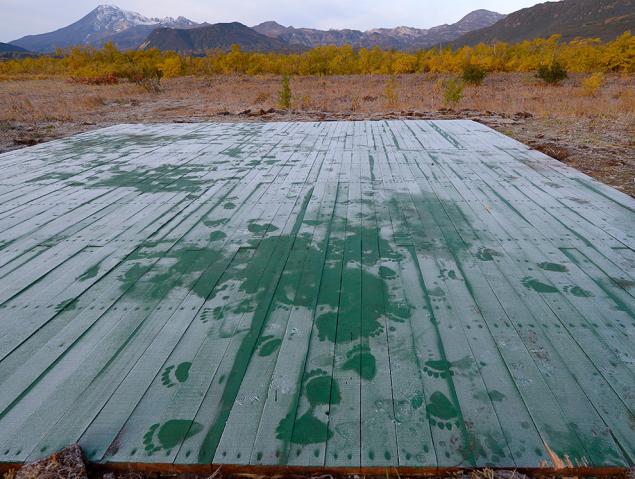
A teddy bear - is not enough, two - rate three - large family, four - a rarity. But not for the Kronotsky Reserve and the South Kamchatka Federal Reserve. It is here that state inspectors and scientists are increasingly watching big bear family. Bear with five cubs:

The abundance of large families bear in nature reserves is due not only an excellent food source (abundance of fish, berries and nuts cedar), but also good protection against poachers:
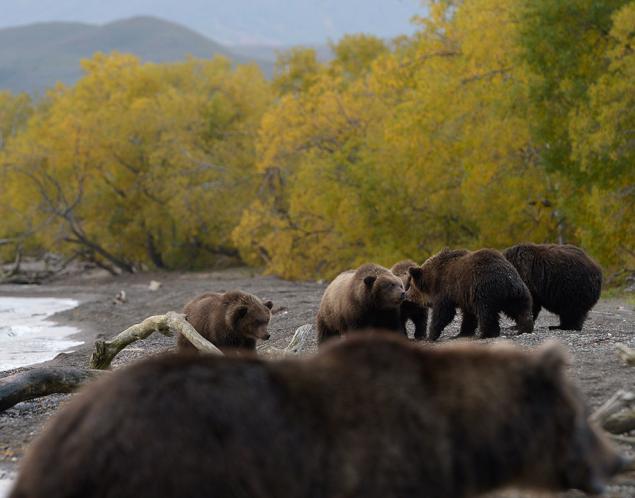
"... 9 miles from the top of the Ozernaya River, and on which its side - is unknown, is whitish utesnaya mountain that does not otherwise seem like a shuttle, set perpendicular, why should the Cossacks call it Batov stone, and thence the pagans say that God Creator of Kamchatka Kutkh before leaving lived there for some time, in the now stone canoes or Baht on the sea and the lake went for catching fish, and on exit therefrom put shuttles to classified stone, and so they are in such esteem by them contained that come close them fear »:
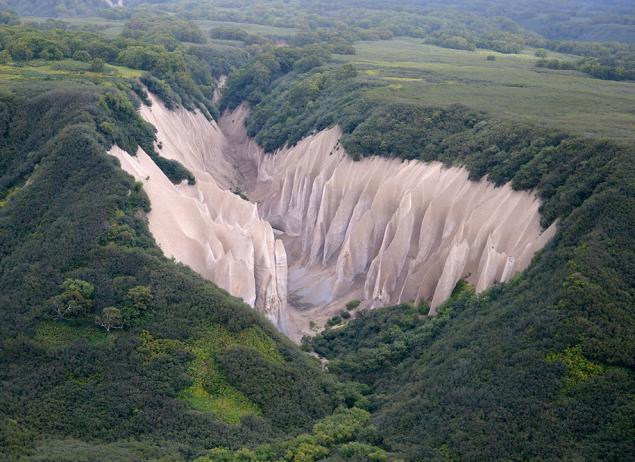
October 10, 2012. The volcano Elias hill. Still, the wind tore off not all yellow leaves. I left a little bit, so that they contradicted the white snow on the volcanoes. Landscape looks incredibly beautiful:
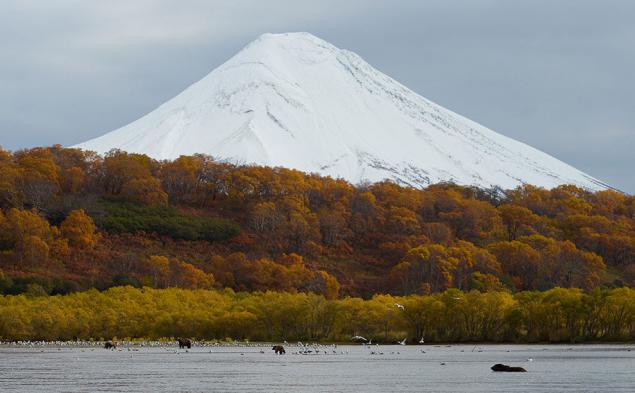
Sleepy Bears. Today froze and dull day. On the bears attacked drowsiness. And if adults Bears somehow resist it, the Bears just fall on the go and fall asleep. They are no longer interested in neither fish nor berries. Probably starts some kind of mechanism of preparation for shallow den, October 11, 2012:
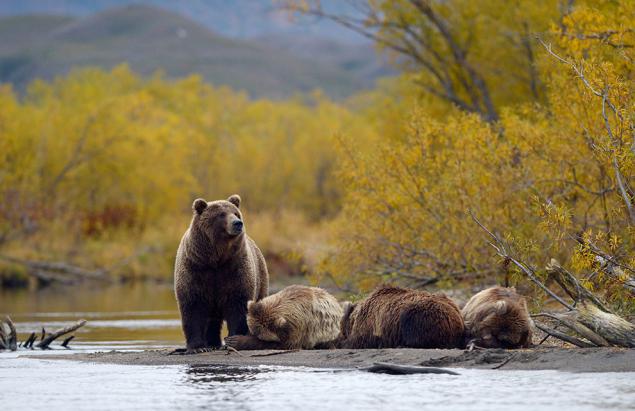
Bears in Kamchatka. Autumn 2012. Portrait:
That's all, thank you for your attention
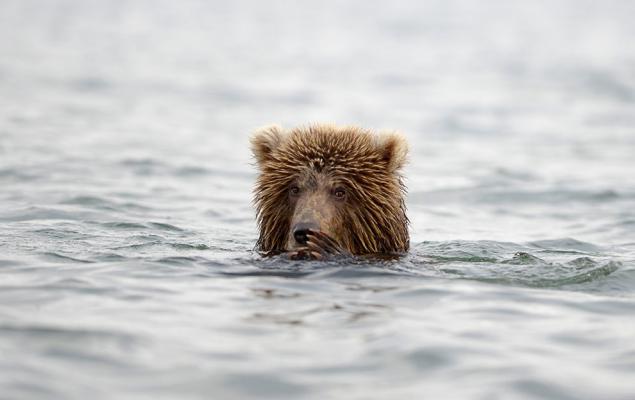
Source:
Photographer Igor Shpilenok

Kuril Lake in Kamchatka - the most bearish in Russia. Apparently, also in the world. Aerial surveys of this year have shown that in the vicinity of the lake inhabited by more than a thousand bears! Yes, that aerial surveys, I myself have repeatedly been able to see here bears to one hundred per day!
Cordon at Cape Grassy - and my favorite place in the Kuril Lake. Tourist season on the lake is nearing completion. Soon the bad weather season. At the inspectors working here comes the holiday season. And for me the off-season - favorite time. So I'll be here for a replacement before winter.

In this picture you can see the entire economy: the left two house inspector. A large building on the right - a hotel for visitors. Buildings are connected by flat wooden pathways. Green Square - helipad:

At the center of the frame - Cape Herb and Kuril Lake. Aerial view:

This picture I made on the first day before sunrise: decided to see how the newly purchased Nikon D4 at dusk. Fortunately I did not have to go far: the closest bear wandered along the beach just a few hundred meters from the cordon:

Uzon Caldera, located on the territory of the Kronotsky Nature Reserve south of the Kronotsky lake on the Kamchatka Peninsula:

Astute readers will have noticed the gray stripes on the previous helicopter shot caldera Uzon. Fortunately, this is not the roads, grazing and wood trails. Wrong those who thought it was a concern for the purity of shoes tourists. These trails are paving where tundra and bog soils are particularly vulnerable. This is especially true for the Valley of the Geysers and the caldera Uzon - a world famous tourist destination. Visitors arriving by helicopter must not leave the wooden decks and paths.
Construction and maintenance of trails in the order - a troublesome and expensive activity, because each board has to take the place of helicopter:

There on unknown paths traces of unseen beasts ...

09

10

Animals on the far cordon:

End of September. It is already the third day of Indian summer. Happy bright, very nekamchatskoe sun, blue sky and blue water, and in the morning to ten o'clock, a thick fog. We wander in a daze, constantly bumping into bears:

13

14

15

16

Nose to nose:

Few talk about the place where I work right now ...
State natural reserve "South Kamchatka" in its present borders was organized in 1983 and is located in the south of the Kamchatka Peninsula. Its area is 322 thousand hectares, including a three-mile surrounding marine area. In addition to the Kurile Lake, under the protection of the reserve there are unique objects such as the active volcanoes Ilyinsky, wild comb Kambalny, Koshelevo, Cape Lopatka, Lake Kambalny Island Utashud.

The reserve protected animals such as sea otters, sea lions, bighorn sheep, white-tailed eagles and Steller's sea eagle, golden eagle, bear, salmon, and many others. This is the only reserve at the federal level in the Kamchatka region. Mode territory close to the reserved, is prohibited in almost all kinds of wildlife, including hunting, commercial fishing, logging, land reclamation, exploration and production of minerals. In 1996, the territory of the reserve was included in the List of World Cultural and Natural Heritage Site by UNESCO as part of the category "Volcanoes of Kamchatka". The reserve is not settlements.
Now more detail about the Kuril Lake. Approximately 8000 ago in the south of Kamchatka, a series of grandiose volcanic disasters. In terms of red-hot debris ejected mass eruption is at least seven to eight times higher than the eruption of Krakatoa in 1883. Melt flow reached both coasts of Kamchatka - Okhotsk and the Pacific.
There is no doubt that in the south of Kamchatka after this eruption some time there was a volcanic desert. All living things, which was not able to move to a safe distance, was destroyed. At the site of a giant failure formed volcanic bowl - a caldera, which gradually began to fill with water. Thus was born the Kuril Lake:

Volcano Elias hill rises above the water table area of 77 square kilometers. The volume of water in the lake of 15 cubic kilometers, the average depth of 195 meters, a complete change of water during 18 years, the average transparency of water in summer - 10 meters. The maximum depth of the lake - 316 meters.
Ilyinsky volcano - one of the most beautiful with the correct conical shape. The height of 1578 meters, the diameter of the base - 8 km. This volcano - the most noticeable decoration in the panorama of the lake. Where the slope of the volcano is in contact with the waters of the Kurile Lake, in the bay of warm, is a hot beach with access to the thermal waters. I made a couple of attempts to relax on this beach, but each time was expelled bears: directly on the narrow strip of sand is the vibrant animal tracks between spawning grounds:

Rock Island Samang:

Lava islands near the volcano Elias hill:

Surrounding neighborhood lake. Hakytsin River, which flows into the lake near the cordon Herbal. The mouth of this river can be clearly seen through the window of my house. Right now there are running the fish heels clumsy ...

Author photo:

Near Cordon at Cape Grassy ... well, there was a bear of very large forms. I nicknamed her Eve:

We continue to get acquainted with bears on Kamchatka. Quarrel:

Evening at the Kuril Lake:

Season fish gluttony. On the cubs are now a sorry sight. Sit, hiccuping and panting heavily, at times falling into a food coma. They look like bloated ticks. Play can no longer. Soon the den ...

Suddenly - a fox. Yet this is not the place of Kamchatka fox:

Early October. Postcard golden autumn in Kamchatka:

Beauty

Volcano

October 7, 2012. The last hours of autumn colors. East wind had pulled from the ocean mane approaching cyclone that sderet leaves of willows and birches, whitewashed mountain peaks and volcanoes with fresh snow. There comes another stage fall ...

Frost

Early in the morning:

Helipad at dawn. Night cordon Grass is always filled with the sounds. The lapping of waves, the sound of a distant waterfall, bear sighs from the bushes. But traces of nightlife Frozen helipad. What they had a disco here?

A teddy bear - is not enough, two - rate three - large family, four - a rarity. But not for the Kronotsky Reserve and the South Kamchatka Federal Reserve. It is here that state inspectors and scientists are increasingly watching big bear family. Bear with five cubs:

The abundance of large families bear in nature reserves is due not only an excellent food source (abundance of fish, berries and nuts cedar), but also good protection against poachers:

"... 9 miles from the top of the Ozernaya River, and on which its side - is unknown, is whitish utesnaya mountain that does not otherwise seem like a shuttle, set perpendicular, why should the Cossacks call it Batov stone, and thence the pagans say that God Creator of Kamchatka Kutkh before leaving lived there for some time, in the now stone canoes or Baht on the sea and the lake went for catching fish, and on exit therefrom put shuttles to classified stone, and so they are in such esteem by them contained that come close them fear »:

October 10, 2012. The volcano Elias hill. Still, the wind tore off not all yellow leaves. I left a little bit, so that they contradicted the white snow on the volcanoes. Landscape looks incredibly beautiful:

Sleepy Bears. Today froze and dull day. On the bears attacked drowsiness. And if adults Bears somehow resist it, the Bears just fall on the go and fall asleep. They are no longer interested in neither fish nor berries. Probably starts some kind of mechanism of preparation for shallow den, October 11, 2012:

Bears in Kamchatka. Autumn 2012. Portrait:
That's all, thank you for your attention

Source:
